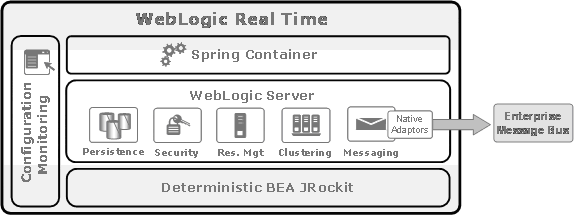









|
This chapter describes the WebLogic Real Time Server architecture.
WebLogic Real Time provides lightweight, front-office infrastructure to allow WebLogic Server 9.1 and BEA JRockit JDK 5.0 with Deterministic Garbage Collection, in combination with a BEA optimized Spring 1.2.6 container, to be used in latency-sensitive, real-time environments, such as the financial services industry.
The components of WebLogic Real Time are illustrated in Figure 2-1.

WebLogic Server 9.1 is a scalable, enterprise-ready Java Two Enterprise Edition (J2EE) application server. The WebLogic Server infrastructure supports the deployment of many types of distributed applications and is an ideal foundation for building applications based on Service Oriented Architectures (SOA). SOA is a design methodology aimed at maximizing the reuse of application services.
The WebLogic Server 9.1 complete implementation of The Sun Microsystems J2EE 1.4 specification provides a standard set of APIs for creating distributed Java applications that can access a wide variety of services, such as databases, messaging services, and connections to external enterprise systems. End-user clients access these applications using Web browser clients or Java clients.
In addition to the J2EE implementation, WebLogic Server enables enterprises to deploy mission-critical applications in a robust, secure, highly available, and scalable environment. These features allow enterprises to configure clusters of WebLogic Server instances to distribute load, and provide extra capacity in case of hardware or other failures. Diagnostic tools allow system administrators to monitor and tune the performance of deployed applications and the WebLogic Server environment itself. You can also configure WebLogic Server to monitor and tune application throughput automatically without human intervention. Extensive security features protect access to services, keep enterprise data secure, and prevent malicious attacks.
For more introductory information on WebLogic Server 9.1, see Introduction to BEA WebLogic Server and BEA WebLogic Express.
Memory management relies on effective garbage collection, which is the process of clearing dead objects from the heap, thus releasing that space for new objects. WebLogic Real Time uses a dynamic "deterministic" garbage collection priority (-Xgcprio:deterministic) that is optimized to ensure extremely short pause times and limit the total number of those pauses within a prescribed window.
For certain types of applications, particularly in the Telecom and Finance industries, stringent requirements are placed on transaction latency. When these applications are written in Java, the unpredictable pause times caused by garbage collection can have a profound and potentially harmful affect on this latency.
However, shorter deterministic pause times do not necessarily equal higher throughput. Instead the goal of the deterministic garbage collection is to lower the maximum latency for applications that are running when garbage collection occurs. Such shorter pause times should lessen the impact of the deterministic garbage collection compared to running a normal garbage collection.
For more information on the deterministic garbage collector, see " Minimal Transaction Latency (The Deterministic Garbage Collector)" in the BEA JRockit Memory Management Guide.
| Note: | For WebLogic Real Time 1.0, this requires acquiring a special JRockit license, as described in " Updating Your BEA JRockit License for the Deterministic Garbage Collector" in the WebLogic Real Time Installation Guide. |
The Spring 1.2.6 Framework for BEA WebLogic Real Time is a lightweight application framework that greatly simplifies the development effort over traditional J2EE development. Spring has proven itself to be very flexible, easy to use, and capable of working in highly latency-sensitive environments. It allows the use of Plain Old Java Objects (POJOs) in the place of EJBs, still allows access to RASP capabilities of an application server, and enforces modular and reusable coding practices.
The Spring 1.2.6 Framework for BEA is fully supported with WebLogic Real Time 1.0 and can be downloaded from the WebLogic Real Time Product download page at http://commerce.bea.com/showproduct.jsp?family=SPRING&major=1.2.6&minor=0. Spring 1.2.6 is also distributed with the WebLogic Real Time CD-ROM kit when the media is ordered.
For more information on the Spring framework for BEA, see:
| Note: | The Spring download link at the end of this white paper is for Spring 1.2.5, which is not the version supported with WebLogic Real Time 1.0. |


|